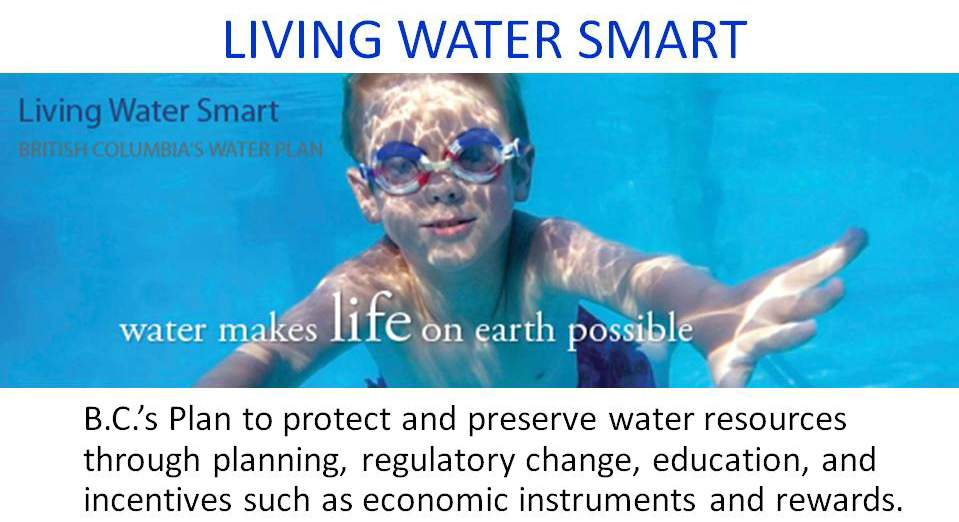“Living Water Smart, British Columbia’s Water Plan” provides backdrop for 2013 Rainwater Harvesting Workshop
Living Water Smart, British Columbia’s Water Plan
Released in 2008, Living Water Smart, British Columbia’s Water Plan sets the direction for changes to use of water and development of land in British Columbia. The desired outcome is water sustainability – both in terms of how water is used and how water runs off the land.
Embedded within Living Water Smart is the Water Sustainability Action Plan for BC. This provides a partnership umbrella for on-the-ground initiatives. The Partnership for Water Sustainability in BC is responsible for program development and delivery.
Water, Water Everywhere….
“The common perception is that BC has an abundance of water…but does it? We are often water-short when demand is greatest. And now our climate is changing,” states Ted van der Gulik, Senior Engineer with the Ministry of Agriculture and Chair of the Water Balance Model Partnership.
 “The 45 actions and targets in Living Water Smart establish expectations for doing business differently. A driver for action is the goal that 50% of new municipal water needs will be acquired through conservation by 2020. In the context of this target or goal, what are the implications and opportunities for rainwater harvesting as a source of water for potable and non-potable uses?”
“The 45 actions and targets in Living Water Smart establish expectations for doing business differently. A driver for action is the goal that 50% of new municipal water needs will be acquired through conservation by 2020. In the context of this target or goal, what are the implications and opportunities for rainwater harvesting as a source of water for potable and non-potable uses?”
“To help deliver Living Water Smart outcomes, the Partnership for Water Sustainability and the Irrigation Industry Association are co-hosting A Workshop on Rainwater Harvesting on December 3, 2013.”
A Call to Action
The Green Communities Initiative complements Living Water Smart and comprises plans, strategies and enabling tools to achieve the land and water stewardship vision. Together, the two initiatives represent a call to action:
Expectations for Living Water Smart
“Living Water Smart is an idea that people are embracing. The solutions and commitments go beyond what government does,” stated Lynn Kriwoken, an Executive Director in the Ministry of Environment and the Province’s lead person for development and delivery of Living Water  Smart, in Chapter 6 of Beyond the Guidebook 2010: Implementing a New Culture for Urban Watershed Protection and Restoration in British Columbia.
Smart, in Chapter 6 of Beyond the Guidebook 2010: Implementing a New Culture for Urban Watershed Protection and Restoration in British Columbia.
“Living Water Smart is a plan that is as much about land as water….because only with healthy water can we enjoy all the values that we take for granted. Times are changing and the way we do business is also changing.”
“At the end of the day, planners and engineers and other disciplines must come together to determine the issues and solutions. While legislative reform is a foundation piece, collaboration takes place outside the legislative framework.”
“By choosing to live water smart, communities will be more prepared for climate change and their quality of life will be enhanced. If we can show how to get the water part right, then other parts are more likely to follow.”
Implementation Themes:
Living Water Smart comprises 45 commitments, which are grouped into five themes. The Partnership for Water Sustainability is playing a key delivery role in two of the five theme areas, namely: community planning and development; and efficient, outreach, public outreach.
Build the Vision, Create the Legacy
“The ultimate goal of the Living Water Smart and Green Communities initiatives is to establish expectations that, in turn, will influence the form and function of the built environment. If land and water practitioners are then successful in bringing a water for life and livelihoods vision to fruition by embracing shared responsibility, this will create a legacy for those who follow in our footsteps,” continued Lynn Kriwoken.
“Living Water Smart is about adaptation – that is, collectively what we need to do…to adapt…to prepare for climate change. How we will get there is all about collaboration – that’s my code for silo jumping. We must get out of our silos and broaden our perspectives. Learn from others, share with others – that is when we grow.”
Cumulative Benefits
“Our immediate objective is to encourage ‘green choices’ that will flow through time, and will be cumulative in creating liveable communities, reducing wasteful water use, and protecting stream health,” concluded Lynn Kriwoken.
“In urban settings, measures that ‘green’ (and improve) the built environment can also protect or help restore the natural environment. How communities choose to develop or redevelop individual sites has ripple effects at the watershed scale. By designing with nature, this means actions on the ground can add up and result in cumulative benefits over time.





